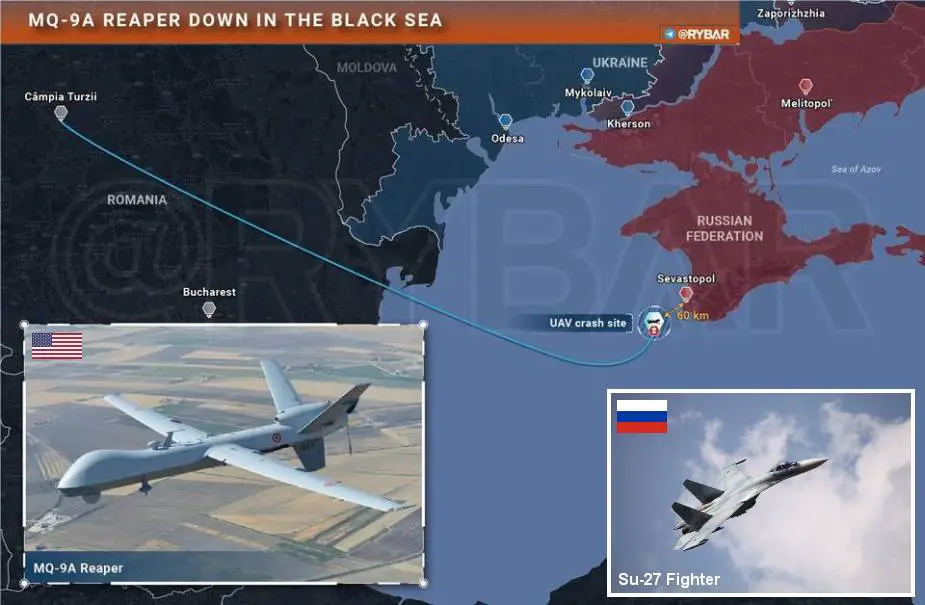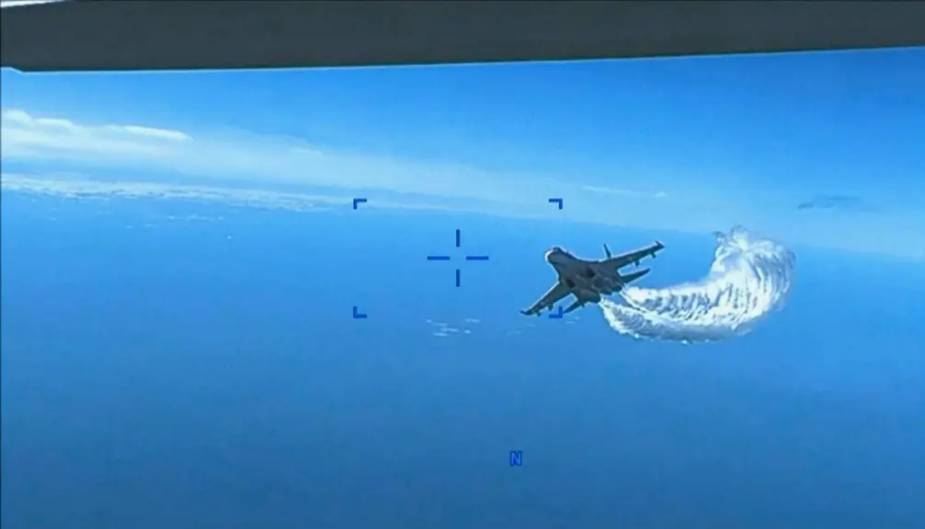Analysis: What precisely happened? US Air Force MQ-9 Reaper lost after collided by Russian Su-27
On March 14, 2023, Brigadier General Pat Ryder, Pentagon press secretary gave a press briefing to comment on the loss of a $32 million U.S. Air Force surveillance MQ-9 Reaper drone hit by a Russian Su-27 fighter. Let us go deeper into the explanation of what happened.
Follow Air Recognition on Google News at this link
 Map showing where the MQ-9 Reaper was intercepted by two Russian Su-27s (Picture source: Telegram @Rybar)
Map showing where the MQ-9 Reaper was intercepted by two Russian Su-27s (Picture source: Telegram @Rybar)
On March 14, USAF’s General Atomics MQ-9 Reaper drone and two Russian Su-27 fighters were flying above the Black Sea in international waters. According to a statement from US European Command, one of the Russian jets deliberately flew in front of the drone and dumped fuel on it several times, obviously to blind its sensors and possibly perturb its flight. While also dumping fuel but more imprudently closer than the first time, the second Su-27 collided with the drone's propeller (in spite of its initial, naive denial by the Russians, the video showing a damaged blade ensuing this collision), essentially putting it in a situation where it was unflyable, uncontrollable, so the US Air Force brought it down in international waters to avoid the high-tech UAV to fall in Russian-held territory or waters.
Pentagon spokesman Brig. Gen. Patrick Ryder stated that the Russian aircraft had been flying "in the vicinity" of the drone for approximately 30 to 40 minutes before the collision occurred just after 7 a.m. Central European Time. Air Force Gen. James B. Hecker, commander of US Air Forces Europe and Air Forces Africa, confirmed that the MQ-9 aircraft was conducting routine surveillance operations in international airspace at the time of the incident. He stated in the press release that "this unsafe and unprofessional act by the Russians nearly caused both aircraft to crash" and resulted in the complete loss of the MQ-9.
Gen. Ryder insisted: "I would like to highlight U.S. European Command's statement released earlier today confirming that two Russian Su-27 aircraft conducted unsafe and unprofessional inter -- an unprofessional intercept with a U.S. Air Force Intelligence Surveillance and Reconnaissance Unmanned MQ-9 aircraft that was operating within international airspace over the Black Sea today. To recap, at approximately 7:03 am Central European time, one of the Russian Su-27 aircraft struck the propeller of the MQ-9 causing U.S. forces to have to bring the MQ-9 down in international waters. Several times before the collision the Su-27s dumped fuel on and flew in front of the MQ-9 in a reckless and unprofessional manner. This incident demonstrates a lack of competence in addition to being unsafe and unprofessional".
U.S. Air Forces in Europe, Air Forces Africa routinely fly aircraft throughout Europe, over sovereign territory and throughout international airspace in coordination with the applicable host nation and international laws, in order to bolster collective European defense and security these missions support allied partners and U.S. national objectives. As the U.S. Air Forces in Europe, Air Forces Africa commander emphasized in the European Command statement, quote, "U.S. and allied aircraft will continue to operate in international airspace, and we call on the Russians to conduct themselves professionally and safely".
The MQ-9 is an ISR platform. These aircraft have been flying over the Black Sea region for some time, including before the current conflict started. It is an important and busy international waterway. And so, it is not an uncommon mission for us to be flying in international airspace. Gen. Ryder said "I'm not going to get into the specific profile of this particular aircraft. As you know, the MQ-9 does have the ability to be armed. It was, again, conducting an ISR mission in international airspace, something that we've been doing for some time. In terms of the types of tactic techniques and procedures that we take to protect our aircraft, I'm not going to get into the specifics. I think the key point here is that while intercepts in and of themselves are not that uncommon, the fact that this type of behavior from these Russian pilots, that is uncommon and unfortunate and unsafe. And so, again, would echo General Hecker's call on the Russians to continue to fly safely".
Both Russian Su-27s did land. "I'm not going to go into where they landed. But again, it just demonstrative of a very unprofessional, unsafe airmanship on the part of these pilots". And afterward, Russia would widely broadcast the official ceremony at the Kremlin showing the pilots receiving an award from President Putin for that "kill".
Concerning the recovery, Gen. Ryder said: "I'm not going to get into the specifics of what's on this particular aircraft, other than it's an ISR platform. Because of the damage, we were in a position to have to essentially crash it into the Black Sea. To my knowledge at this point in time, the Russians have not recovered that aircraft, but again, in terms of our recovery efforts, don't have any updates to provide right now. I'd refer you to NAVEUR, in terms of what assets they may have in that region".
Russian Security Council Secretary Nikolay Patrushev accused the United States of participating in hostilities in Ukraine because of the presence of its drone in the international airspace, which appears as a strange accusation for the international airspace is an international "open/free-fly zone". The Russians later said the drone had entered – or was about to enter – a no-fly zone clearly notified to the relevant international authorities in the framework of their "special military operation" in Ukraine.
The Russians already said they will try to retrieve the MQ-9 Reaper, the U.S. facing trouble operating in the Black Sea, Turkey having closed the access straits. The Russian ambassador in the U.S. gave an invalid version of the threat posed by the approaching MQ-9 Reaper, saying that this kind of drone can carry "thousands of kilos of explosive" and, hence, posed a serious threat to Russian territory. No: the various devices an MQ9 Reaper can carry are external and, hence, easy to identify. The Su-27 pilots extensively described the drone to their commander, and probably filmed dit, perfectly enabling the Russians to see that the Reaper did not carry any offensive weapon but only ISR devices.
 This screenshot from a video released by the U.S. DoD shows a Russian Su-27 approaching the back of the U.S. MQ-9 Reaper drone and beginning to release fuel to blind its sensors. (US Department of Defense)
This screenshot from a video released by the U.S. DoD shows a Russian Su-27 approaching the back of the U.S. MQ-9 Reaper drone and beginning to release fuel to blind its sensors. (US Department of Defense)
History of other incidents
The most famous incident of a US drone shoot-down is the destruction of an RQ-4 Global Hawk by Iran in June 2019. This unarmed surveillance drone was operating in the Gulf of Oman near the Strait of Hormuz, a highly trafficked waterway that borders Iran on one side and the Arabian Peninsula on the other. Iran claimed the Global Hawk was shot down within Iran’s territorial waters; the United States argued instead that the drone was operating in international waters. While the crisis did not escalate beyond the destruction of the drone, it was unclear at the time that this incident would end calmly.
Reapers have been shot down by militaries including the US Air Force. In 2009, US pilots lost control of an MQ-9 Reaper over Afghanistan, so a crewed fighter shot it down proactively before it crashed into another country.
General Atomics MQ-9 Reaper
MQ-9 Reaper is an unmanned aerial vehicle (UAV) used primarily for military and reconnaissance purposes. It is developed by General Atomics Aeronautical Systems (GA-ASI) and is an upgraded version of the earlier MQ-1 Predator drone. The Reaper is designed for long-endurance and high-altitude surveillance missions, and is capable of carrying a range of weapons, including air-to-ground missiles and bombs. It has a wingspan of 66 feet and can fly at altitudes of up to 50,000 feet for more than 24 hours.
The drone is operated remotely by a pilot and sensor operator on the ground, who can control the aircraft and its various sensors, including cameras and radar systems. The Reaper has been used extensively by the US military in operations in Afghanistan, Iraq, and other locations around the world, namelu the Black Sea in the framework of the war triggered by Russia in Ukraine. It has also been sold to other countries for military and surveillance purposes.
• The Reaper has a length of 36 feet and a height of 12.5 feet. Its maximum takeoff weight is 10,500 pounds.
• It is powered by a Honeywell TPE331-10 turboprop engine, which provides a maximum speed of around 300 miles per hour.
• The drone's range is over 1,000 nautical miles, and it can fly for over 27 hours with external fuel tanks.
• The Reaper is equipped with a variety of sensors, including a synthetic aperture radar (SAR), a multi-spectral targeting system (MTS), and an electro-optical/infrared (EO/IR) camera. These sensors can be used to gather intelligence, surveillance, and reconnaissance (ISR) data on ground targets.
• The drone can carry a variety of weapons, including Hellfire missiles, GBU-12 Paveway II and GBU-38 Joint Direct Attack Munitions (JDAMs), and GBU-49 Enhanced Paveway II bombsThe Reaper is controlled by a ground control station (GCS), which consists of a pilot station and a sensor operator station. The GCS communicates with the drone using a satellite link or a line-of-sight radio link.
• The drone has a fully redundant flight control system and can operate in all weather conditions. It also has automatic takeoff and landing capabilities.
The Reaper is used by the US Air Force, US Navy, and other military forces around the world. It has been used for a variety of missions, including intelligence gathering, surveillance, and strike operations.
The Reaper is used by the US Air Force, US Navy, and other military forces around the world. It has been used for a variety of missions, including intelligence gathering, surveillance, and strike operations.
Sukhoi Su-27
The Su-27 is a Russian-made, single-seat, twin-engine, fourth-generation fighter jet designed and manufactured by the Sukhoi Design Bureau. It was introduced into service with the Soviet Air Force in the 1980s, and it remains in service with various air forces around the world.
Technical specifications
* Crew: 1
* Length: 21.9 m (72 ft)
* Wingspan: 14.7 m (48 ft)
* Height: 5.9 m (19 ft)
* Wing area: 62.0 m² (667 ft²)
* Empty weight: 16,380 kg (36,100 lb)
* Max takeoff weight: 30,450 kg (67,100 lb)
* Powerplant: 2 × Saturn AL-31F turbofans, 123 kN (27,600 lbf) each with afterburner
Performance
* Maximum speed: Mach 2.35 (2,500 km/h, 1,550 mph) at altitude
* Range: 3,530 km (1,860 nmi, 2,190 mi) with internal fuel
* Service ceiling: 18,500 m (60,700 ft)
* Rate of climb: 325 m/s (64,000 ft/min)
* Wing loading: 492 kg/m² (101 lb/ft²)
* Thrust/weight: 0.81
Armament
* 1 × 30 mm Gryazev-Shipunov GSh-30-1 cannon with 150 rounds
* 10 hardpoints for missiles, bombs, rockets, and external fuel tanks
* Up to 6,500 kg (14,330 lb) of ordnance on external pylons
The Su-27 is a highly maneuverable fighter jet with a delta wing configuration and can operate at high altitudes and speeds. It is equipped with a radar and infrared search and track system, and it can carry a variety of air-to-air and air-to-surface missiles, as well as bombs and rockets.


























